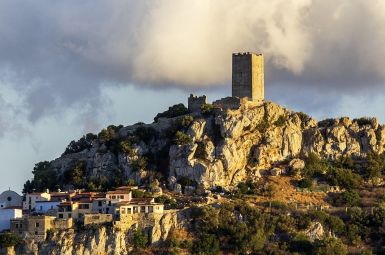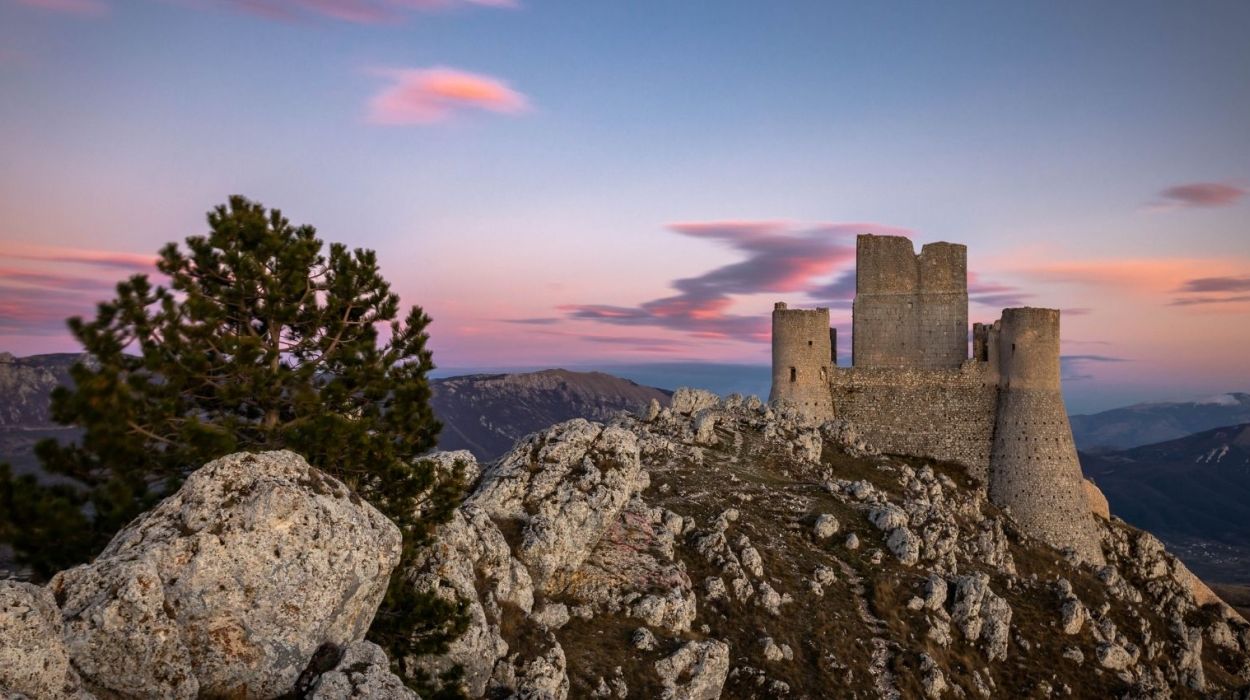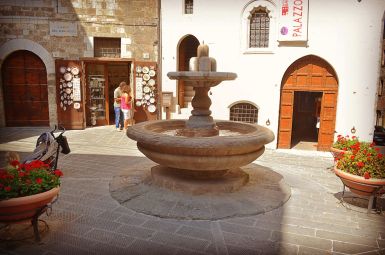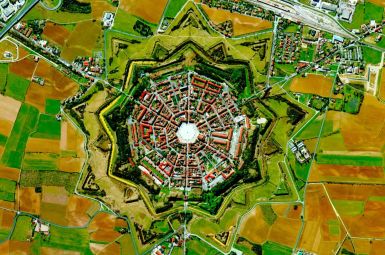
Rocca Calascio
Il Borgo di Rocca Calascio
Rocca Calascio: La Fortezza Sospesa tra Cielo e Leggenda
Rocca Calascio (AQ) non è un semplice castello: è un’epica visione in pietra calcarea, il punto più alto in cui la storia medievale incontra l’immensità selvaggia dell’Abruzzo. Arroccato a circa 1460 metri di altitudine, dominando la Piana di Campo Imperatore e la Valle del Tirino, questo fortilizio è universalmente riconosciuto come uno dei castelli più belli e suggestivi del mondo. Rocca Calascio è la meta definitiva per chi cerca l’atmosfera autentica, la storia intatta e un panorama che abbraccia la Catena del Gran Sasso e la Majella, fino a intravedere, nelle giornate più limpide, l’Adriatico.Il Castello Più Alto degli Appennini
La sua maestosità deriva dalla perfetta fusione tra l’architettura militare e il paesaggio montano.- Struttura Imponente: Realizzata interamente in candida pietra locale, la Rocca presenta una robusta pianta quadrata, affiancata da quattro torri cilindriche angolari e un imponente mastio centrale. La sua funzione era cruciale: un baluardo difensivo e un punto d’osservazione strategico in grado di comunicare con gli altri fortilizi vicini tramite segnali luminosi.
- Il Borgo Fantasma: Ai piedi della fortezza si estende il borgo omonimo, quasi interamente disabitato a seguito del devastante terremoto del 1703. Le sue rovine, restaurate con cura, aggiungono un senso di profonda malinconia e fascino, permettendo al visitatore di respirare l’atmosfera di un villaggio medievale cristallizzato nel tempo.
Hollywood e il Grande Cinema
L’aura misteriosa e la bellezza mozzafiato di Rocca Calascio l’hanno resa una location cinematografica di fama internazionale.- Set di Capolavori: Il castello è celebre per essere stato il set naturale di film cult che hanno sfruttato la sua architettura solitaria e l’ambiente da fiaba. Tra i più famosi si ricordano:
- Ladyhawke (1985), che lo ha consacrato nell’immaginario fantasy.
- Il Nome della Rosa (1986), con Sean Connery.
- Altri film e serie TV, confermando la sua vocazione di luogo fuori dal tempo.
Santa Maria della Pietà: Fede e Panorama
Poco distante dalla Rocca, sorge un altro monumento emblematico in uno scenario di eccezionale valore paesaggistico.- Architettura Unica: La Chiesa di Santa Maria della Pietà, costruita tra il XVI e il XVII secolo, sorprende per la sua rara pianta ottagonale sormontata da una cupola.
- Leggenda di Briganti: Si narra che la sua costruzione sia stata voluta dagli abitanti di Rocca Calascio per ringraziare la Vergine dopo aver sbaragliato una temuta banda di briganti che infestava le montagne. Oggi è un oratorio, un luogo di pellegrinaggio e una tappa fotografica imperdibile.
Rocca Calascio non si visita, si conquista. Raggiungerla a piedi è un’esperienza catartica. Dalla sua cima, sentirai il vento dell’Appennino e vedrai l’Abruzzo distendersi ai tuoi piedi, una terra di storia e meraviglie indomite. Sei pronto a vivere la magia di questa fortezza leggendaria?

Il Borgo d’Italia
tutto da scoprire ed esplorare
Monumenti
Rocca Calascio Monumentale: Le Architetture Eterne tra Cielo e Terra
Rocca Calascio (AQ) non possiede monumenti nel senso urbano del termine; essa è un monumento, una straordinaria sintesi di architettura militare e paesaggio, riconosciuta a livello internazionale per la sua bellezza drammatica. I suoi punti di interesse non sono semplici costruzioni, ma testimonianze integre di storia medievale, incastonate a quasi 1500 metri d’altezza nel Parco Nazionale del Gran Sasso e Monti della Laga.
Questi sono i due pilastri in pietra e fede che definiscono la grandezza, la solitudine e il fascino di Rocca Calascio.
1. Il Castello di Rocca Calascio: La Fortezza Sospesa
Dominando la Piana di Campo Imperatore, il Castello è il simbolo indiscusso, una delle fortezze più alte e iconiche d’Italia e d’Europa.
- Pietra Calcarea e Geometria Perfetta: Costruito prevalentemente con la pietra calcarea bianca locale, il Castello presenta una struttura quadrangolare con quattro torri angolari cilindriche e un mastio centrale più alto. La sua estetica è tanto imponente quanto essenziale, pensata per una funzione strategica di avvistamento e difesa sul territorio.
- Sentinella Cinematografica: La sua maestosa solitudine ha fatto sì che fosse scelto come location per grandi produzioni cinematografiche, come Ladyhawke e Il Nome della Rosa, rendendolo un monumento non solo storico ma anche dell’immaginario fantasy medievale.
- Il Borgo Abbandonato: Ai piedi della fortezza si trova il borgo medievale disabitato, un insieme di case diroccate ma suggestive che furono abbandonate dopo il terremoto del 1703. La passeggiata tra queste rovine è un monumento alla memoria, dove il tempo sembra essersi fermato.
2. La Chiesa di Santa Maria della Pietà: L’Eremo Ottagonale
Poco più in basso del Castello, in una radura isolata, sorge un’architettura sacra di sorprendente eleganza.
- Un Gioiello Rinascimentale: La Chiesa di Santa Maria della Pietà è un piccolo ma perfetto oratorio a pianta ottagonale, con un corpo cilindrico e una cupola a otto spicchi. La sua architettura austera ma armoniosa, tipica di un rinascimento montano, la rende un punto focale di grande impatto visivo.
- La Leggenda della Vittoria: La tradizione vuole che sia stata eretta per commemorare la vittoria degli abitanti contro un gruppo di briganti, un atto di ringraziamento che testimonia la resilienza e la fede della comunità.
- Luce e Panorama: La Chiesa, oggi un monumento nazionale, offre una delle inquadrature fotografiche più famose d’Abruzzo, incorniciata dalle vette del Gran Sasso e dal Castello in lontananza.
Rocca Calascio è la destinazione per chi cerca un’esperienza più che una visita: un luogo dove il silenzio delle pietre è interrotto solo dal vento, e i monumenti dominano il mondo sottostante. Sei pronto a salire fino a toccare il cielo?
Curiosità
Rocca Calascio: Curiosità e Leggende del Castello Sospeso nel Tempo
Rocca Calascio (AQ) non è una semplice fortezza: è un’icona globale, un castello di roccia calcarea che sembra sfidare la gravità e le leggi del tempo. Arroccato nel cuore del Parco Nazionale del Gran Sasso e Monti della Laga, a quasi 1500 metri di altitudine, questo luogo non è celebre solo per la sua bellezza, ma per le incredibili storie e i fatti curiosi che lo circondano.
Dalle leggende cinematografiche ai misteri del suo isolamento, ecco le curiosità che rendono Rocca Calascio una meta indimenticabile.
1. La Star di Hollywood
La bellezza eterea e l’atmosfera immutabile di Rocca Calascio l’hanno trasformata in un set cinematografico di fama mondiale, portando l’Abruzzo sugli schermi internazionali.
- Il Castello di Ladyhawke: Il film più celebre girato qui è “Ladyhawke” (1985), che ha consacrato la Rocca nell’immaginario fantasy come il castello maledetto. Il regista Richard Donner scelse la fortezza proprio per la sua solitudine e l’ambiente incontaminato.
- Da Sean Connery a George Clooney: La Rocca compare anche in capolavori come “Il Nome della Rosa” (1986), con Sean Connery, e nel più recente “The American” (2010), con George Clooney, dimostrando il suo fascino cinematografico senza tempo.
2. Il Castello Più Alto degli Appennini
La sua posizione geografica non è solo suggestiva, ma storicamente cruciale e unica nel panorama italiano.
- Dominio Verticale: Rocca Calascio è considerata la fortezza più alta d’Italia e d’Europa tra quelle costruite esclusivamente a scopo difensivo. La sua posizione le permetteva di controllare un vastissimo territorio, dalle valli interne fino, nelle giornate più limpide, al Mar Adriatico.
- Sistema di Comunicazione: Grazie all’altezza, il castello faceva parte di un ingegnoso sistema di avvistamento e comunicazione basato su segnali di fuoco e fumo, collegando rapidamente diverse fortezze del Gran Sasso e garantendo un controllo capillare sul territorio.
3. Il Borgo Fantasma e il Terremoto
La Rocca oggi svetta solitaria perché il borgo che la serviva fu devastato da un evento naturale.
- L’Abbandono: Il borgo sottostante fu quasi completamente abbandonato dopo il terremoto del 1703, che danneggiò gravemente anche il castello stesso. Gran parte delle case furono lasciate in rovina, creando l’atmosfera “fantasma” che oggi ne accresce il fascino.
- La Rinascita Tarda: Il castello rimase in uno stato di rovina per oltre due secoli, finché non vennero intrapresi importanti lavori di restauro negli anni ’80 che lo hanno salvato dalla distruzione totale e reso visitabile gratuitamente.
4. La Leggenda della Chiesa Ottagonale
Poco più in basso del castello sorge l’elegante Chiesa di Santa Maria della Pietà, che nasconde una storia di coraggio e fede.
- Pianta Ottagonale: La sua forma unica, a pianta centrale ottagonale, è rara per l’architettura religiosa di montagna.
- La Vittoria sui Briganti: La leggenda più diffusa narra che la chiesa fu eretta in ringraziamento alla Madonna per aver aiutato gli abitanti di Calascio a sconfiggere una temuta banda di briganti che imperversava nella zona, unendo così fede popolare e storia locale.
Rocca Calascio è un’esperienza sensoriale e storica: è il vento che fischia tra le torri, il panorama che ti toglie il fiato, e la consapevolezza di camminare dove la storia ha incontrato la fantasia. Sei pronto a scalare la leggenda?
Personaggi
Rocca Calascio: I Grandi Nomi Nati nel Cuore della Pietra
Rocca Calascio (AQ), pur essendo un piccolo e, in gran parte, disabitato borgo d’alta quota, non è rimasto estraneo alla storia e alla cultura. L’ambiente austero e la posizione strategica hanno forgiato spiriti tenaci, le cui radici affondano nella storia medievale e rinascimentale dell’Abruzzo interno.
Sebbene l’isolamento geografico abbia limitato l’emergere di figure di fama internazionale, la storia di Calascio e della sua Rocca è ricca di personalità che furono centrali per l’economia e la politica del territorio, specialmente in relazione alle famiglie feudali e all’amministrazione.
Le Dinastie e gli Amministratori Chiave
I personaggi più significativi di Calascio sono spesso legati ai feudatari e alle figure che amministravano il territorio cruciale per il commercio della lana.
- La Famiglia Piccolomini: Sebbene non nativa di Calascio, questa potente famiglia senese, in particolare Antonio Piccolomini d’Aragona, fu tra i feudatari più importanti della zona a partire dal XV secolo. Il loro dominio sul Castello di Rocca Calascio fu fondamentale per l’espansione e la fortificazione della struttura, trasformandola da semplice torre di guardia in una vera e propria fortezza. Essi non erano “nati” nel borgo, ma ne hanno plasmato la storia architettonica e politica in modo inequivocabile.
- Figure Istituzionali Locali: Nel corso dei secoli, i registri di Calascio riportano nomi di Notai, Sindaci e Amministratori che, grazie alla ricchezza derivante dalla transumanza e dal commercio della lana (essendo l’area vicina a Santo Stefano di Sessanio, un centro laniero chiave), ebbero un peso significativo nella politica della Baronia di Carapelle, la circoscrizione a cui apparteneva la Rocca.
L’Eredità della Tradizione Orale
In un borgo montano, l’importanza di una figura non è sempre misurata dai documenti accademici, ma dalla capacità di trasmettere l’identità del luogo.
- Custodi della Memoria: Più che “celebrità” moderne, i veri personaggi noti di Rocca Calascio sono stati gli anziani e i pastori che, generazione dopo generazione, hanno tramandato le leggende legate al castello, le storie dei briganti e la sapienza della vita in alta quota. Senza di loro, l’anima di questo “borgo fantasma” non sarebbe giunta fino a noi.
Rocca Calascio ci insegna che l’importanza di un luogo a volte è misurata dalle storie che esso ha ispirato, più che dalle figure che vi sono nate. I suoi veri eroi sono coloro che hanno mantenuto viva la fortezza, che hanno resistito al sisma e che oggi la raccontano. Vuoi scoprire le leggende che avvolgono questa Rocca eterna?
Ricette Tipiche
Rocca Calascio: La Cucina Essenziale delle Alte Vette Abruzzesi
Rocca Calascio (AQ), con la sua altitudine e la sua storia legata alla pastorizia e all’isolamento, vanta una tradizione culinaria che è un vero inno alla resilienza e alla genuinità. Qui non si cerca la complessità, ma l’esaltazione dei sapori primari: quelli che i pastori e gli abitanti del borgo, tra le mura del castello e la Piana di Campo Imperatore, potevano procurarsi con fatica.
La cucina di Calascio è robusta, profonda e utilizza sapientemente i prodotti ovini, i legumi e le erbe selvatiche, offrendo un pasto che sa di storia e di montagna.
1. I Primi: Il Sapore del Grano Duro e dei Legumi
I primi piatti sono la base della dieta montana, spesso ricchi di sostanza per affrontare le temperature rigide.
Cicerchie (o Ceci) con Erbe di Campo
Un piatto che celebra i legumi locali, coltivati nell’altopiano, e le erbe selvatiche raccolte in quota.
- Essenza Rustica: Le cicerchie (un legume antico) o i ceci vengono cotti a lungo e conditi con olio d’oliva extra vergine, aglio e peperoncino. La particolarità sta nell’aggiunta delle erbe spontanee (come la cicoria selvatica o il grespino), che conferiscono al piatto un sapore amaro-dolce e un profumo intenso, tipico della vegetazione di montagna.
Maccheroni alla Chitarra del Gran Sasso
Sebbene condivisi con l’Abruzzo intero, qui i maccheroni esprimono un legame indissolubile con l’allevamento locale.
- Ragù di Castrato e Zafferano: A Calascio, spesso la pasta (tagliata con il telaio della “chitarra”) viene abbinata a un ricco ragù a base di carne di castrato (montone giovane) o agnello. In alcune varianti tradizionali, soprattutto in occasioni di festa, il condimento viene impreziosito da un pizzico del pregiato Zafferano di Navelli (presidio Slow Food), che cresce proprio nelle valli sottostanti, aggiungendo un colore e un aroma regale.
2. I Secondi: La Gloria della Pecora e della Brace
L’economia pastorale fornisce i protagonisti assoluti della tavola.
Arrosticini di Pecora
L’icona gastronomica dell’Abruzzo, in questa zona trovano la loro espressione più pura e autentica.
- Carne di Qualità: Gli arrosticini (spiedini di carne ovina tagliata a cubetti) vengono preparati con carne di pecora o castrato di alta qualità. Cucinati rigorosamente su una brace accesa in un braciere a canalina (furnacella), vengono serviti caldissimi, semplicemente salati e accompagnati da pane casareccio unto con olio. Un sapore che è pura montagna.
Pecora o Castrato in Pignata (o al Cutturo)
Un piatto di pazienza e tradizione, ideale per i banchetti o i giorni freddi.
- Cottura Lenta: La carne viene stufata per ore in una pentola di coccio (pignata o cutturo) con acqua, patate, cipolle, pomodorini e aromi. Questa preparazione prolungata rende la carne particolarmente tenera e il brodo ricco, trasformando la carne di pecora, notoriamente tenace, in un comfort food.
3. I Prodotti della Terra e i Dolci
La vicinanza a Campo Imperatore e alla conca Aquilana garantisce prodotti unici.
Ricotta, Pecorino e Caciocavallo di Campo Imperatore
Direttamente dai pascoli circostanti, questi formaggi rappresentano la base dell’identità gastronomica.
- La Ricchezza del Pascolo: Il sapore intenso e aromatico di questi latticini è un riflesso diretto delle erbe e dei fiori d’alta quota. Vengono consumati freschi o stagionati, e sono l’accompagnamento ideale per i salumi locali, anch’essi ricavati da suini allevati in modo semi-brado.
La cucina di Rocca Calascio è un’esperienza essenziale che onora l’antica sapienza contadina e pastorale. Ti aspetta una tavola che sa di roccia, di pascolo e di storie di confine. Sei pronto ad assaggiare il gusto intatto dell’alta montagna abruzzese?


